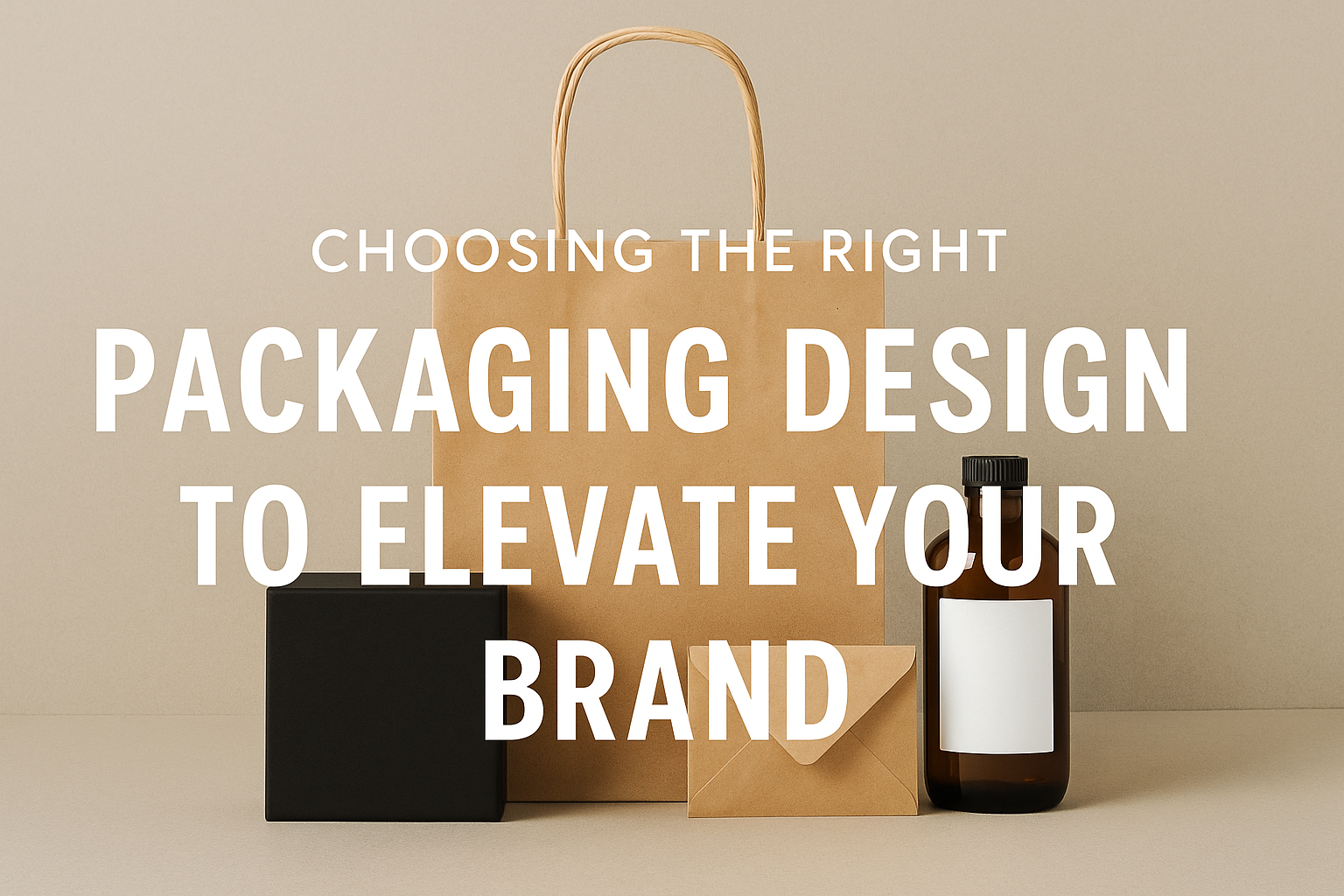Packaging Materials Explained: From Kraft to Bioplastics
The Ultimate Guide for Brands Choosing the Right Packaging
Packaging is more than just a container. It is the first brand impression your customers see, and it determines sustainability impact, cost efficiency, and product performance. With dozens of materials on the market, choosing the right one can feel overwhelming.
This guide explains the most common packaging materials—from kraft paper to bioplastics—along with their pros, cons, and best applications. Use it as your roadmap to select packaging that protects products, aligns with your brand values, and earns customer loyalty.
Why Packaging Material Choice Matters
The material you choose affects every part of your business:
Product safety during shipping and handling
Customer experience at unboxing and on the shelf
Sustainability footprint in recycling or composting
Cost structure in both materials and freight
Brand perception — premium, eco-friendly, or budget
The right decision blends performance, cost, and customer expectations. Let’s dive into the top options.
Kraft Paper: The Classic Eco-Friendly Choice
Kraft paper has been a staple for decades. Made from unbleached wood pulp, it is recyclable, compostable, and instantly recognizable as an eco option.
Best for: Mailers, shopping bags, food wraps, corrugated liners
Pros: Affordable, recyclable, compostable, customizable
Cons: Limited barrier protection against moisture and grease
Kraft is ideal for small products, apparel, candles, or lifestyle goods where natural branding matters.
Recommended suppliers:
EcoEnclose Kraft Mailers
Sticker Mule Custom Kraft Tape
Corrugated Cardboard: The Workhorse of Shipping
Corrugated cardboard is the backbone of e-commerce and retail logistics. Its fluted middle layer provides cushioning and stack strength.
Best for: Shipping boxes, subscription packaging, retail displays
Pros: Durable, recyclable, stackable
Cons: Bulkier than paper, not naturally moisture-resistant
Kraft vs Corrugated at a Glance:
FeatureKraft PaperCorrugated CardboardCostLowLow–MediumStrengthMediumHighRecyclabilityHighHighBest UseSmall/light itemsShipping & subscription
Corrugated is the best choice for subscription boxes or branded e-commerce shipments.
Recommended suppliers:
Uline Corrugated Shipping Boxes
Packhelp Custom Printed Boxes
Plastics: Durable but Under Pressure
Plastic remains one of the most widely used materials thanks to its strength and barrier properties.
Types:
PET (water bottles, food containers)
HDPE (detergent bottles)
LDPE (stretch film, mailer bags)
Pros: Lightweight, strong, excellent for moisture or oxygen barriers, cost-efficient
Cons: Environmental concerns, low recycling rates, regulatory scrutiny
If you ship liquids, frozen goods, or products needing moisture protection, plastics are still a reliable option.
Recommended suppliers:
EcoEnclose 100% Recycled Poly Mailers
West Marine Heavy-Duty Plastic Storage Bins
Bioplastics: The Renewable Alternative
Bioplastics are made from renewable resources such as corn, sugarcane, or algae. They represent a growing category in sustainable packaging.
Pros: Renewable, compostable in some cases, lower carbon footprint
Cons: Higher cost, limited durability, often require industrial composting
A Nielsen study found that 73% of consumers are willing to pay more for sustainable packaging—making bioplastics a strong option for eco-forward brands.
Best for: Foodservice, cafés, direct-to-consumer eco brands
Recommended suppliers:
Eco-Products PLA Cold Cups
WorldCentric Compostable Food Containers
Glass and Aluminum: Premium and Sustainable
Both glass and aluminum provide durability and full recyclability—while instantly signaling premium value.
Glass
Pros: Reusable, recyclable, premium appearance
Cons: Heavy, fragile
Best for: Beverages, cosmetics, gourmet foods
Aluminum
Pros: Lightweight, endlessly recyclable, strong barrier
Cons: Higher cost than plastics
Best for: Beverages, trays, specialty goods
Recommended suppliers:
Berlin Packaging – Glass Jars & Bottles
Ball – Aluminum Beverage Cans
Flexible Packaging Films: Space-Saving and Shelf-Ready
Flexible packaging, such as pouches and films, has surged in popularity for food, supplements, and lifestyle products.
Pros: Lightweight, customizable, cost-efficient, strong branding potential
Cons: Many laminates are not recyclable
Flexible vs Rigid Packaging:
FeatureFlexible FilmsRigid Options (Glass/Aluminum)WeightLightHeavyCostLowerHigherShelf PresenceModeratePremiumRecyclabilityLimitedHigh
Flexible films are ideal for coffee, snacks, powdered mixes, and retail-ready pouches.
Recommended suppliers:
Arka Custom Stand-Up Pouches
Sticker Mule Resealable Pouches
Sustainable Innovations to Watch
The packaging landscape is evolving quickly. Keep an eye on these game-changers:
Mushroom Packaging (mycelium-based): Compostable alternative to Styrofoam
Supplier: Ecovative
Seaweed Films: Edible and biodegradable packaging
Supplier: Notpla
Plant-Based Fibers: Trays and packaging made from agricultural waste
Supplier: Loliware
Forward-thinking brands that experiment now will build differentiation and regulatory resilience.
How to Choose the Right Packaging for Your Brand
There is no universal “best” material—only the one that fits your product and goals. Here’s a framework:
Product type: Fragile? Perishable? Heavy?
Customer expectations: Eco-friendly? Premium? Convenient?
Brand values: Sustainability, luxury, affordability
Cost factors: Balance upfront cost with long-term savings
Compliance: Ensure certifications and recyclability meet market standards
Pro Tip: Many brands mix materials for optimal results. For example:
Corrugated boxes for outer shipping
Kraft inserts for eco-friendly branding
Compostable tape or film for sealing
Final Takeaway
Packaging is both a cost and an opportunity. Choosing the right material can:
Protect products during shipping
Reduce returns and replacements
Improve sustainability scores
Enhance unboxing and shelf impact
Build customer trust and loyalty
Quick Reference:
Kraft & Corrugated = Affordable staples
Plastics = Moisture and barrier protection
Bioplastics & Fiber = Renewable and future-proof
Glass & Aluminum = Premium look and recyclability
Flexible Films = Lightweight and cost-efficient
Your packaging is more than protection. It is a profit lever and a brand statement. Choose wisely, test consistently, and let your packaging tell your story.
Where to Start:
Compare sustainable mailers at EcoEnclose
Design custom boxes with Packhelp
Explore compostable packaging at WorldCentric




